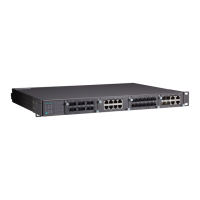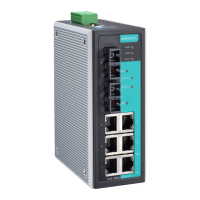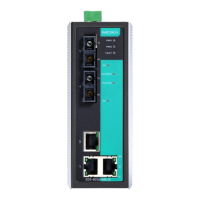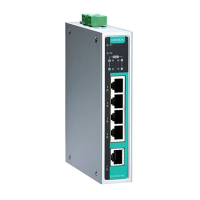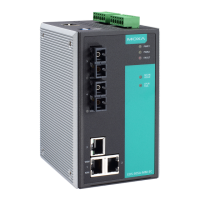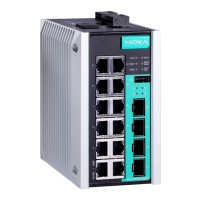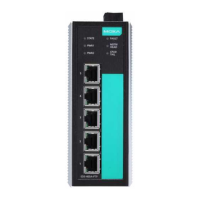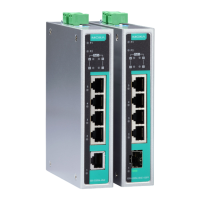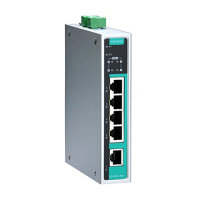Moxa Managed Ethernet Switch (UI_2.0_FW_5.x) User Manual
VLANs and the Rackmount switch
Your Moxa switch provides support f or VLANs using IEEE Std 802.1Q-1998. This standard allows traf f ic f rom
multiple VLANs to be carried across one physical link. The IEEE Std 802.1Q-1998 standard allows each port
on your Moxa switch to be placed as f ollows:
• On a single VLAN def ined in the Moxa switch
• On several VLANs simultaneously using 802.1Q tagging
The standard requires that you def ine the 802.1Q VLAN ID f or each VLAN on your Moxa switch bef ore the
switch can use it to forward traffic:
Managing a VLAN
A new or initialized Moxa switch contains a single VLAN—the Def ault VLAN. This VLAN has the f ollowing
def inition:
• VLAN Name—Management VLAN
• 802.1Q VLAN ID—1 (if tagging is required)
All the ports are initially placed on this VLAN, and it is the only VLAN that allows you to access the
management software of the Moxa switch over the network.
Communication Between VLANs
If devices connected to a VLAN need to communicate with devices on a different VLAN, a router or Layer 3
switching device with connections to both VLANs needs to be installed. Communication between VLANs can
only take place if they are all connected to a routing or Layer 3 switching device.
VLANs: Tagged and Untagged Membership
The Moxa switch supports 802.1Q VLAN tagging, a system that allows traf f ic for multiple VLANs to be
carried on a single physical link (backbone, trunk). When setting up VLANs you need to understand when to
use untagged or tagged membership of VLANs. Simply put, if a port is on a single VLAN it can be an
untagged member, but if the port needs to be a member of multiple VLANs, a tagged membership must be
def ined.
A typical host (e.g., clients) will be an untagged member of one VLAN, defined as an Access Port in a Moxa
switch, while an inter-switch connection will be a tagged member of all VLANs, def ined as a Trunk Port in a
Moxa switch.
The IEEE Std 802.1Q-1998 def ines how VLANs operate within an open packet-switched network. An 802.1Q
compliant packet carries additional inf ormation that allows a switch to determine which VLAN the port
belongs to. If a f rame is carrying the additional inf ormation, it is known as a tagged f rame.
To carry multiple VLANs across a single physical link (backbone, trunk), each packet must be tagged with a
VLAN identifier so that the switches can identify which packets belong in which VLAN. To communicate
between VLANs, a router must be used.
The Moxa switch supports three types of VLAN port settings:
• Access Port: The port connects to a single device that is not tagged. The user must def ine the def ault
port PVID that assigns which VLAN the device belongs to. Once the ingress packet of this Access Port
egresses to another Trunk Port (the port needs all packets to carry tag information), the Moxa switch
will insert this PVID into this packet so the next 802.1Q VLAN switch can recognize it.
• Trunk Port: The port connects to a LAN that consists of untagged devices, tagged devices, and/or
switches and hubs. In general, the traf f ic of the Trunk Port must have a Tag. Users can also assign a
PVID to a Trunk Port. The untagged packet on the Trunk Port will be assigned the default port PVID as
its VID.
• Hybrid Port: The port is similar to a Trunk port, except users can explicitly assign tags to be removed
from egress packets.

